Learn about the mystique of Aaron's biblical garments, revealing secrets of divine connection and ancient spirituality.
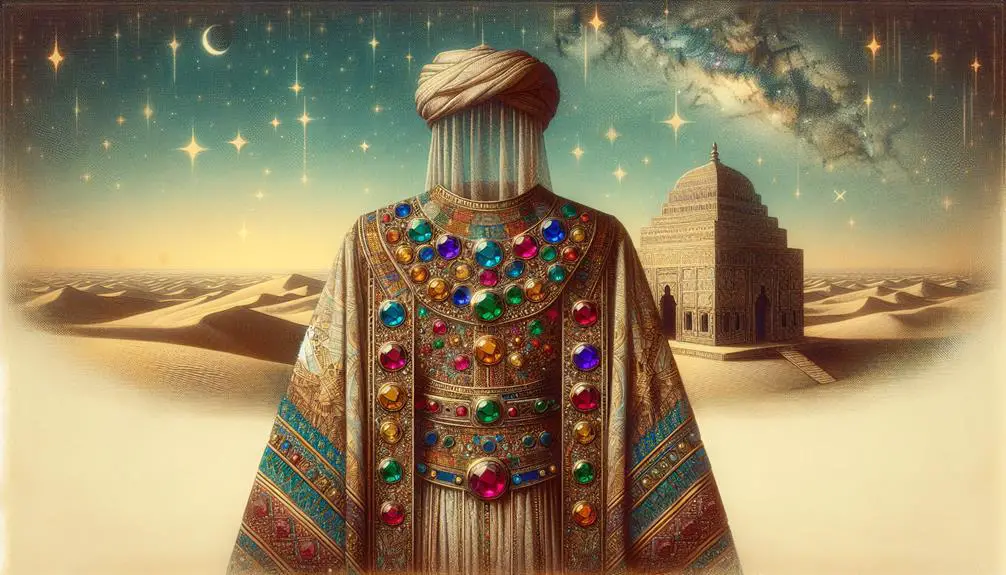
Aaron's Garments in the Bible
Just like the intricate tapestries of the ancient world, Aaron's garments weave a complex narrative of spirituality, leadership, and divine command.
You might find yourself intrigued by the symbolism embedded in each thread and gemstone, from the ephod's sacred significance to the mysterious Urim and Thummim.
Each element serves not just a ceremonial purpose but carries a deeper message about the relationship between the divine and the earthly realm.
As you explore the layers behind these sacred vestments, you'll uncover insights that resonate far beyond their ancient origins, inviting you to ponder their relevance in today's world.
Key Takeaways
- Aaron's garments symbolized his sacred role and the unity of the Israelite tribes.
- The use of specific materials and colors held deep spiritual and symbolic meanings.
- The Urim and Thummim, part of his attire, facilitated divine guidance for Israel.
- Aaron's attire underscored his intermediary role between God and the people.
The Ephod's Sacred Significance

Why does the ephod hold such profound significance in the context of Aaron's garments, as outlined in biblical scripture? To understand this, you've got to delve into the craftsmanship details and the divine instructions that dictated its creation.
The ephod, as described in Exodus, isn't just any piece of clothing; it's a masterpiece that symbolizes a direct link between the divine and the mortal, specifically crafted for Aaron as the High Priest.
The divine instructions for its creation are meticulous, emphasizing its uniqueness and sacredness. You're told of a garment woven from gold, blue, purple, and scarlet yarn, materials that in themselves carry deep symbolic meanings. The gold represents divinity and purity, while the colors blue, purple, and scarlet symbolize depth, royalty, and sacrifice, respectively. These aren't random choices; they're deliberate, reflecting the ephod's role as not just a garment but a vessel for spiritual and ritualistic significance.
Further, the craftsmanship details are no less fascinating. The ephod required skilled artisans, those whom the scripture notes were specially endowed with wisdom, to weave it. This wasn't an ordinary task but a divine commission, ensuring that the ephod wasn't only aesthetically pleasing but also perfect in its symbolic functions. The detailed work, including the attachment of the ephod to the High Priest, underscores its role as a bridge between God and Israel, manifesting God's presence and guidance.
In essence, the ephod's significance goes beyond its physical appearance. It embodies divine instructions, meticulous craftsmanship, and a profound spiritual purpose, setting it apart as a central element of Aaron's sacred garments.
Breastplate of Judgment Explored
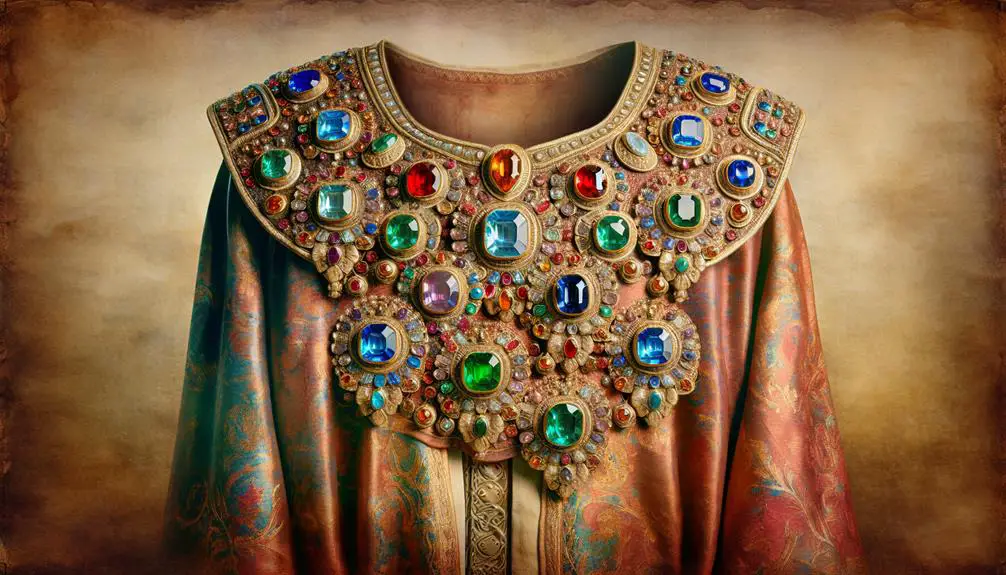
Having explored the ephod's sacred significance, we now turn our attention to another critical element of Aaron's garments, the Breastplate of Judgment, which equally embodies profound spiritual and ritualistic meaning within the biblical texts. This piece of attire isn't just a garment; it's a meticulously crafted artifact, rich in symbolism and functionality, particularly in its gemstone meanings and craftsmanship details.
At the heart of its significance, the Breastplate of Judgment served as a divine medium, facilitating communication between God and His people. Crafted with precision, it was adorned with twelve gemstones, each representing one of Israel's tribes. The choice and arrangement of these stones weren't arbitrary but deeply symbolic, reflecting a divine order and connection between God's creation and His laws.
- Gemstone Meanings: Each gemstone embedded within the breastplate carried a unique significance, symbolizing the character and destiny of the tribe it represented. From the ruby's strength to the topaz's beauty, every stone was a testament to the diversity and unity of God's people.
- Craftsmanship Details: The breastplate's construction was an act of devotion and skill. It was made from gold, blue, purple, and scarlet yarns, and fine twisted linen, symbolizing royalty, divinity, sacrifice, and purity, respectively.
- Divine Communication: Through the Breastplate of Judgment, the high priest could discern God's will, making it a vital tool for guidance and decision-making.
- Holiness and Proximity to God: Wearing the breastplate, Aaron stood before God on behalf of the people, symbolizing their collective sanctity and chosen status.
- Symbolic Representation: The breastplate's design and elements underscored the unity and diversity of the Israelite community under divine watchfulness.
The Breastplate of Judgment, with its intricate design and profound symbolism, stands as a pivotal element in the narrative of Aaron's garments, offering insights into the spiritual and ritualistic fabric of biblical times.
Symbolism of the Urim and Thummim
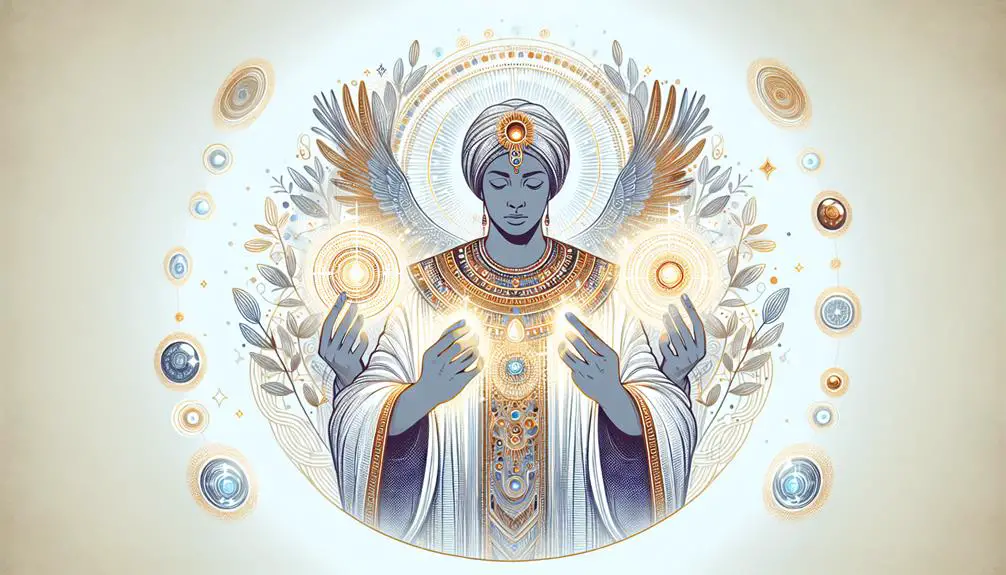
Delving deeper into the symbolic elements of Aaron's garments, the Urim and Thummim emerge as pivotal tools for divine guidance, embodying a complex interplay of faith and decision-making within the ancient Israelite tradition. These elements, concealed within the Breastplate of Judgment, weren't merely ornamental but were crucial for clerical decisions, representing a direct line to God's will.
You'll find that the Urim and Thummim's very names hint at their role in discernment and guidance. 'Urim' is often translated as 'lights,' and 'Thummim' as 'perfections,' suggesting their function in illuminating the path of righteousness and leading to perfect decisions. This dual nature underscores the balance between knowledge and morality, guiding the High Priest in making judgments that weren't just wise but morally sound.
Their usage illustrates an early form of casting lots, yet with a profound difference: it was believed that through the Urim and Thummim, God Himself directed the outcome. This belief in divine guidance through physical objects highlights the deep intertwining of faith and daily life in ancient Israel. Clerical decisions, especially those affecting the community or relating to the divine will, required more than human wisdom; they needed divine endorsement.
Moreover, the presence of the Urim and Thummim within the High Priest's garments symbolizes the close relationship between God and His appointed intermediaries. They served as a reminder that, though the High Priest was a leader among men, his authority and wisdom were ultimately derived from and guided by the divine.
In this way, the Urim and Thummim stand not just as tools of divine guidance, but as symbols of the broader theological principle that God's will is accessible and can guide the community through its appointed leaders.
The Robe of the Ephod
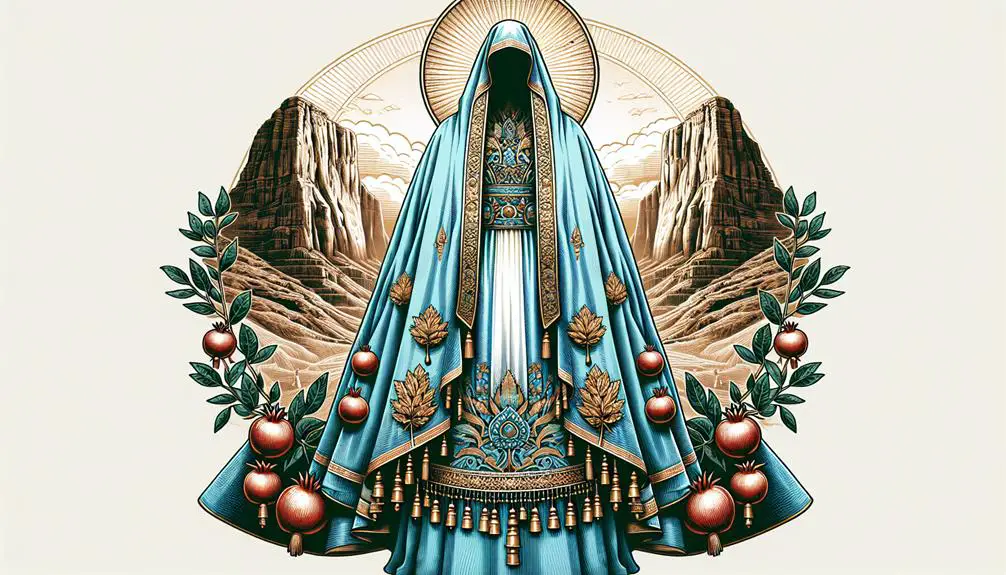
Transitioning from the symbolic Urim and Thummim to the Robe of the Ephod, we encounter another vital element in the sartorial repertoire of Aaron, which serves not merely as a garment but as a profound symbol of his priestly function and the divine wisdom it embodies. The Robe of the Ephod, rich in fabric choices and imbued with color symbolism, stands as a testament to the intricate relationship between divine service and material representation.
In analyzing this garment, you'll find:
- Fabric Choices: The choice of fabric, often blue wool, isn't arbitrary. This material signifies not only durability and functionality but also embodies heavenly attributes, aligning Aaron with the divine.
- Color Symbolism: Blue, the predominant color of the robe, symbolizes the sky and the heavens. This color choice serves to remind the Israelites of their constant connection to God and his overarching presence.
- Construction Details: The meticulous construction of the robe, with its woven work and lack of seams, signifies unity and wholeness, reinforcing Aaron's role as a mediator between God and the people.
- Decorative Elements: The hem of the robe, adorned with bells and pomegranates, fulfills both a practical and symbolic function. The sounds announce Aaron's movements, safeguarding his life, and the fruits symbolize fertility and abundance.
- Symbolic Function: Beyond its physical attributes, the robe represents a mantle of authority and sanctity, distinguishing Aaron as a key figure in the spiritual and communal life of the Israelites.
Through these elements, the Robe of the Ephod illustrates the profound interplay between divine service, material culture, and symbolic meaning, anchoring the sacred garments in a context of religious and cultural significance.
The Golden Plate's Message
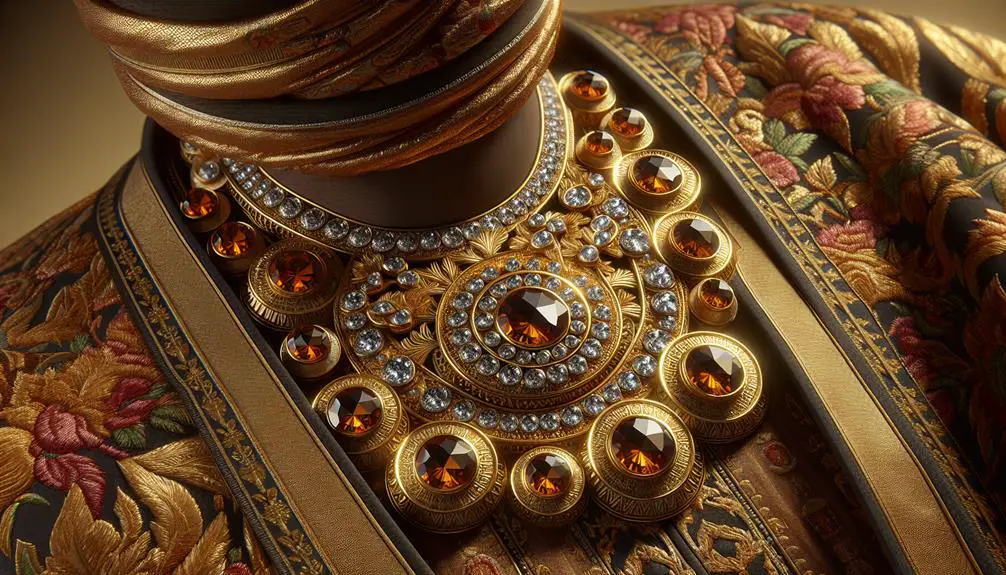
You must consider the golden plate, worn on Aaron's forehead, as a pivotal element in understanding his priestly garments.
The inscription's significance ties directly to its divine mandate, embodying a sacred connection between the priest and God.
Moreover, the specific instructions for its wear not only ensure compliance with ritual purity but also symbolize a continuous atonement for the Children of Israel.
Inscription Significance
Within the biblical account, the inscription on Aaron's golden plate, often translated as 'Holy to the LORD,' holds profound theological significance, symbolizing not only Aaron's consecration but also reflecting broader themes of sanctity and divine designation. This inscription:
- Highlights the unique status of Aaron among the Israelites, setting him apart for ceremonial functions.
- Serves as a perpetual reminder of the sacred duties entrusted to the priesthood.
- Influences artistic interpretations, enriching the visual culture of religious communities.
- Reinforces the concept of divine selection, emphasizing that Aaron's role isn't self-appointed but ordained by God.
- Acts as a symbolic bridge between the divine and the earthly, underscoring the mediator role of the high priest in religious rites.
Wearing Instructions
Having explored the profound significance of the inscription on Aaron's golden plate, let's now examine the specific instructions for wearing this sacred adornment, as outlined in biblical texts, to understand its intended function and symbolic role in religious ceremonies.
Aspect |
Details |
|---|---|
Fabric Choice |
Aaron's garments were made from specific fabrics, chosen for their symbolic meanings and durability, ensuring they were fit for sacred duties. |
Placement |
The golden plate was to be worn on the forehead, symbolizing enlightenment and divine wisdom. |
Maintenance Rituals |
Regular cleansing and inspection rituals were crucial to maintain the sanctity and purity of the garments. |
Symbolic Role |
Serving as a constant reminder of Aaron's role as an intermediary between the divine and the Israelites. |
This attention to detail underscores the deep symbolic significance and meticulous care required in the priestly role.
Woven Tunic and Turban
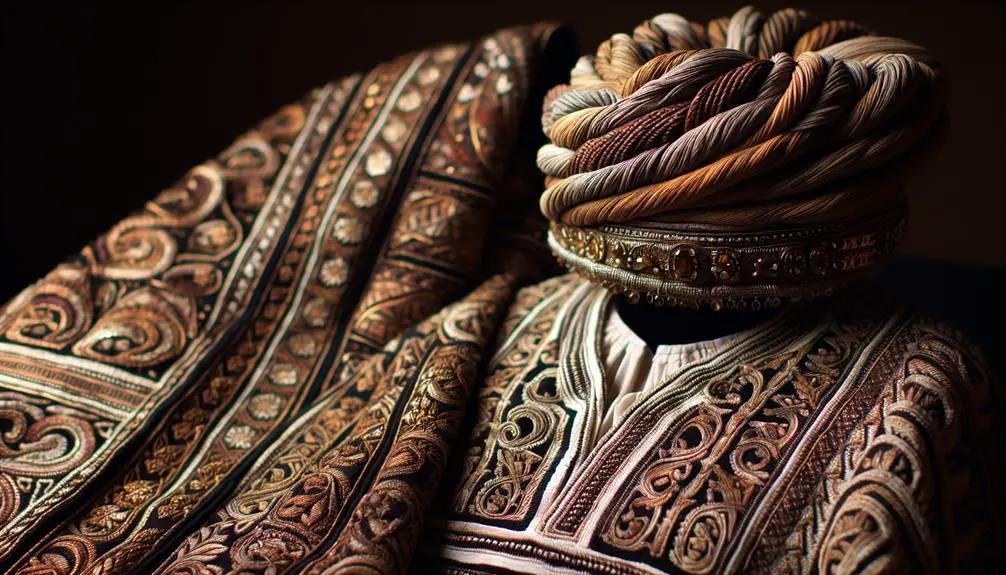
You must consider the woven tunic's symbolic meaning, emphasizing its role in representing Aaron's sanctity and separation for divine service.
Similarly, the turban's priestly significance is crucial, as it symbolizes purity and the weight of Aaron's spiritual responsibilities.
These garments not only served functional purposes but also conveyed deep theological messages within the context of ancient Israelite worship.
Tunic's Symbolic Meaning
The woven tunic and turban, integral elements of Aaron's garments, symbolize a deep spiritual significance within the biblical narrative. The fabric significance and color symbolism of these garments underscore their sacred purpose and the priestly identity they confer.
- *Fabric Significance*: Represents purity and divine selection, indicating the wearer's sanctified role.
- *Color Symbolism*: Embodies spiritual concepts such as wisdom, divinity, and redemption.
- *Sanctity and Separation*: Highlights the bearer's consecration from mundane to divine service.
- *Intercessory Role*: Suggests the mediator's position between the divine and the human realms.
- *Unity with Divine Will*: Symbolizes alignment and harmony with God's purposes.
These components together weave a rich tapestry of meaning, underscoring the tunic's role in bridging the earthly with the heavenly.
Turban's Priestly Significance
While exploring the symbolic layers of Aaron's garments, it's crucial to examine the turban's role in signifying priestly authority and divine connection. The turban, often overlooked, embodies a profound spiritual and societal significance. Its intricate design and the sacred act of donning it underscore the wearer's consecration to divine service.
Cultural adaptations have seen the turban's symbolism evolve, reflecting varying interpretations across communities and epochs. Modern interpretations further delve into its significance, often emphasizing the turban's role in bridging the human with the divine, serving as a tangible representation of one's dedication to higher principles.
This evolution of meaning showcases the turban's enduring relevance, highlighting its capacity to convey deep religious and cultural narratives within and beyond the biblical context.
Bells and Pomegranates: A Detailed Look
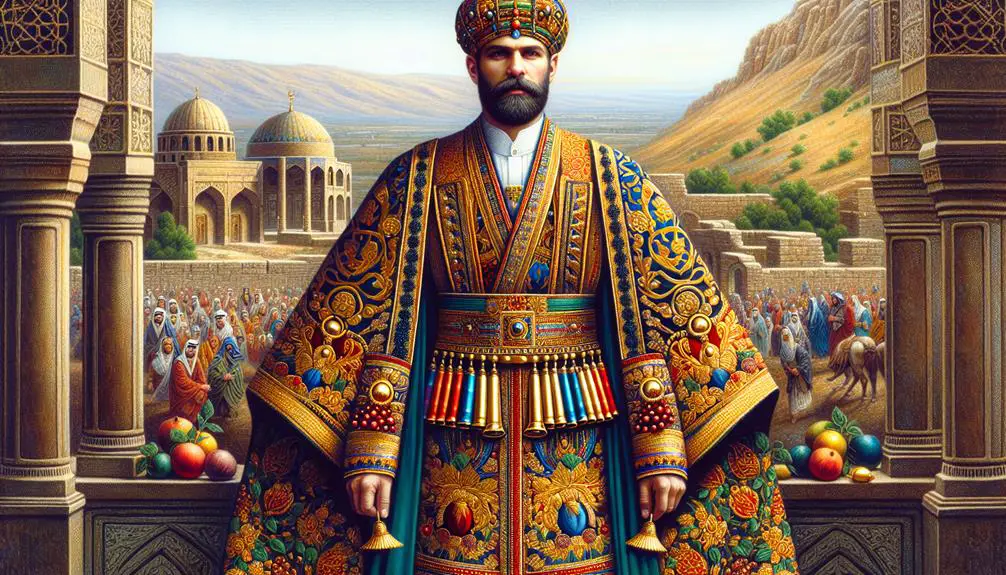
Delving into the significance of bells and pomegranates adorning Aaron's garments requires an understanding of their symbolic resonance within ancient Hebrew culture. These elements weren't merely decorative; they carried deep spiritual and functional meanings. The fabric composition of the garments, meticulously described in biblical texts, and their artistic interpretation underscore the sanctity and purpose of Aaron's role as High Priest.
- Symbol of Divine Presence: The bells' melodious sounds announced Aaron's entry into the Holy of Holies, symbolizing an open communication line with the Divine. It was a reminder that his approach was sanctioned and holy.
- Protection Against Judgment: Tradition holds that the sound of the bells also served to protect Aaron from divine judgment, ensuring his safety within the sacred space.
- Pomegranates as Symbols of Righteousness: The pomegranates, with their numerous seeds, symbolized fertility, abundance, and the multitude of commandments to be kept by the faithful.
- Unity of the Spiritual and Material: The alternating pattern of bells and pomegranates on the hem of the garment represented a balance between the audible and the tangible, intertwining spiritual duties with the physical world.
- Artistic and Cultural Representation: Beyond their religious implications, the inclusion of these elements highlighted the craftsmanship and artistic sensibilities of the time, reflecting a broader cultural appreciation for beauty and symbolism.
The bells and pomegranates on Aaron's garments thus serve as a profound study in how physical artifacts can embody spiritual truths and principles, bridging the divine with the material world.
Frequently Asked Questions
How Did the Process of Creating Aaron's Garments Influence the Local Economy and Trade in Ancient Israel?
When considering how a high-profile clothing project influences local economies, it's clear the textile trade benefits significantly. The creation of such garments likely spurred demand for fine materials, boosting the textile trade and having a notable economic impact.
Skilled artisans would've been in high demand, possibly leading to advancements in trade skills and techniques. This ripple effect could enhance economic stability and growth, demonstrating the profound influence of major projects on local industries and economies.
Were There Any Specific Rituals or Ceremonies Involved in the Initial Wearing or Consecration of Aaron's Garments?
Yes, there were specific rituals for the initial wearing or consecration of these garments, marked by profound ritual significance.
At the heart of garment consecration, a fascinating ritual unfolded involving anointment, sacrifices, and symbolic actions, underscoring the garment's sanctity.
This ceremony wasn't merely a formality; it was a deeply spiritual process, intertwining the physical and divine realms.
This consecration process highlighted the garments' role beyond mere clothing, embodying spiritual and societal dimensions.
How Did the Design and Symbolism of Aaron's Garments Evolve Over Time, Particularly During the Second Temple Period?
When exploring the textile evolution and symbolic interpretation over time, especially during the Second Temple period, you'll find that religious garments underwent significant changes.
This transformation wasn't just about style or fashion, but deeply rooted in evolving theological concepts and societal shifts.
The designs became more intricate, reflecting a deeper symbolic interpretation, embodying a broader range of spiritual meanings and connections to divine worship.
This period marked a critical phase in the development of religious attire.
Can Any Parallels Be Drawn Between the Design of Aaron's Garments and the Attire of Religious Leaders in Other Ancient Cultures?
You'll find that many religious leaders' attire across ancient cultures shares similarities with Aaron's garments, influenced by cultural exchanges and evolving interpretations.
Modern interpretations highlight how these designs weren't isolated but part of a broader tapestry of religious expression. Analyzing these parallels offers insights into how cultural influences shaped religious symbols, demonstrating a shared human inclination towards creating meaningful, distinctive symbols of spiritual leadership and divine connection across different civilizations.
How Has Modern Archaeological Research Contributed to Our Understanding of the Materials and Techniques Used to Make Aaron's Garments?
Ever wondered how experts uncover the secrets of ancient textiles? Thanks to modern archaeological research, you're in luck.
Fabric analysis has revolutionized our understanding of ancient clothing, revealing the intricate techniques once used. By examining remnants, researchers can identify dye sources, providing insights into the trade networks of the past.
This method doesn't just apply to any old garments; it's a window into the sophistication and skill of ancient artisans.
Conclusion
In the intricate weave of Aaron's garments, you uncover layers of sacred significance and divine command. The ephod stands as a symbol of spiritual connection, while the breastplate of judgment underscores the weight of divine decisions.
The Urim and Thummim, nestled within, whisper of divine guidance; the robe of the ephod, the golden plate, the woven tunic, and the turban each carry messages of purity, holiness, and divine selection.
Moreover, the bells and pomegranates, through their resonant sounds and symbolic richness, harmonize the sacred with the serviceable, underscoring the seamless blend of beauty and duty in divine worship.
This ensemble not only clothed Aaron but also articulated a theology of presence, priesthood, and purity, embodying the profound intersection of the divine with the tangible, where every thread and ornament serves as a testament to the meticulous care with which the divine engages with the world.

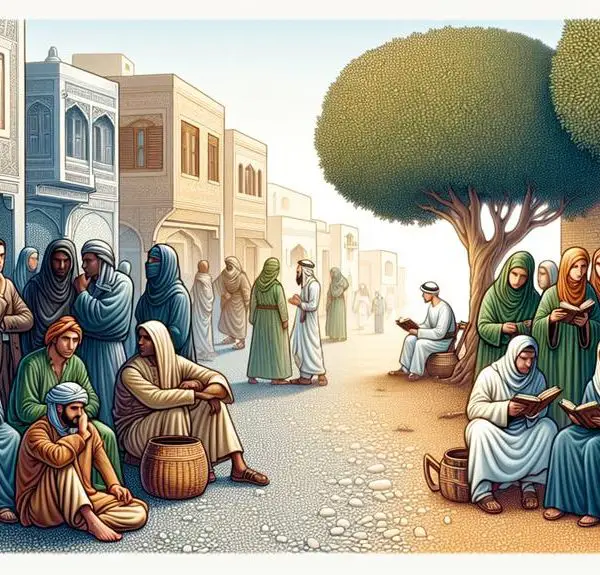
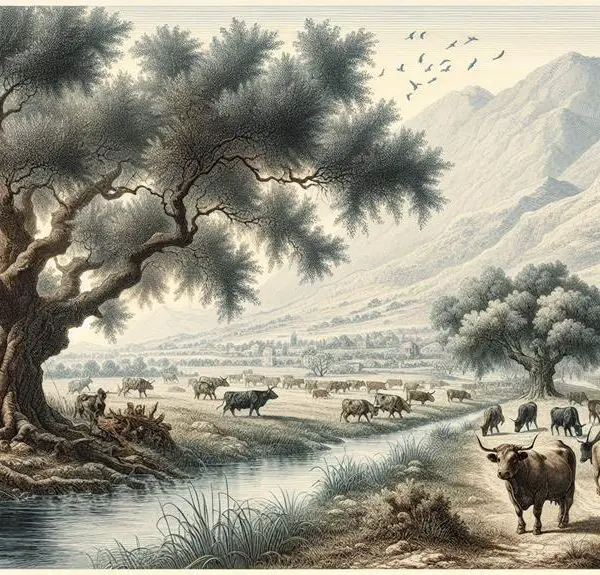
Sign up